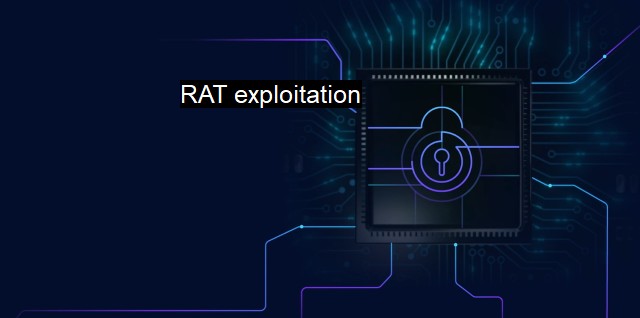What is RAT exploitation?
Cybersecurity and Antivirus Under Siege: The Hidden Threat of RAT Exploitation - An Eye-Opening Introduction
RAT, an abbreviation for Remote Administration Tool or Remote Access Trojan, is a malware program that encompasses back-door access capabilities, allowing unauthorized individuals to gain control over a device. A RAT typically enters a device through a hidden file attachment or as resident within a seemingly harmless software package. When mistaken as legitimate software and installed, the RAT provides the attacker complete control over the device. This incidence is termed "RAT Exploitation," an undesirable situation within the cybersecurity landscape.RAT Exploitation is particularly formidable due to its surreptitious nature and versatility in facilitating various forms of cyberattacks. The attacker, or the 'rat,' can remotely control the compromised system as if they physically owned the system. This includes accessing sensitive information, downloading and installing other malicious software, changing device settings, observing user activity and even recording keystrokes. With a strategy debated as an advanced persistent threat, RAT exploitation has far-flung implications on an organization's cybersecurity strategy, rendering it among the top-level requisites.
An attacker implements RAT exploitation primarily using 'social engineering,' or technological manipulation techniques. The most common method is spear-phishing, where an attacker impersonates a trusted source to deceive users into downloading an email attachment or clicking a link, both carrying the RAT hidden. Following this, the attacker can spy, steal sensitive data or cause system damage. Another popular method leverages security vulnerabilities in the existing software that paves the way for a complete takeover.
Detecting a RAT infection is challenging due to the rat's innate ability to hide well, concurrently manipulating the infected system. Classic symptoms include unusual computer behavior like system slowdown, sudden frequential crashes, or excessive network traffic. The overall performance downgrade stems from the extraneous processes, services, or files the RAT employs to maintain back door access. Detailed examination of processes, network traffic, security logs, etc., is essential in identifying the potential presence of a RAT.
The fast-evolving and highly sophisticated nature of RAT exploitation schemes demands stringent countermeasures. Deploying robust antivirus software forms the first line of defense. Advanced antivirus solutions employ heuristic analysis to look beyond the virus definitions, thereby able to detect previously unknown RATs. They offer real-time protection, scanning all file access, and attempts, including internet downloads and e-mail attachments, enriching the device's auto-immunity.
Another defense strategy against RAT exploitation includes rigorous screening of downloading software. Because RATs often sneak into systems hidden within legitimate-looking software, the rule of thumb is to avoid downloading software from unverified sources. Instead, opting for trustworthy platforms and vendors promotes cybersecurity. Timeliness is another component as regular software updates ensure ample security reinforcements, minimizing potential entry points.
Understanding the tell-tale signs of a potential RAT exploitation and taking immediate action is crucial. Reporting suspicious activities to IT personnel, ceasing non-sanction applications immediately, and regular system checks are a few practices that help counter exploitation. continuous user education on the safe usage of email and internet goes a long way towards creating a secure environment.
RAT exploitation, a severe cyber-security threat, is disarmingly tough to detect and can precipitate devastating breaches. An amalgamation of rigorous defensive strategies can mitigate the impact of such exploits. Cultivating such cyber hygiene among users and organizations as a whole, threads the route towards achieving a secure cyber landscape.

RAT exploitation FAQs
What is rat exploitation?
Rat exploitation refers to the use of a Remote Access Trojan (RAT) to gain unauthorized access to a victim's computer or network. It is a common tactic used by cybercriminals to steal sensitive data, install malware or carry out other malicious activities.How can I protect my computer from rat exploitation?
You can protect your computer from rat exploitation by installing a reliable antivirus software that can detect and remove RATs. It is important to keep your antivirus software updated and regularly scan your system for any potential threats. Additionally, avoid clicking on suspicious links or downloading unknown files.What are the signs of rat exploitation on my computer?
Some signs of rat exploitation on your computer include slow performance, crashing or freezing applications, pop-up windows, changes to your desktop or browser settings, and an overall sense of computer instability. If you suspect your computer has been compromised by a RAT, seek professional cybersecurity help immediately.What should I do if I have been a victim of rat exploitation?
If you have been a victim of rat exploitation, the first step is to disconnect your device from the internet to prevent further damage. Then, run a full virus scan, and remove any detected RATs. Change all of your passwords and enable two-factor authentication wherever possible. Finally, report the incident to your IT department or a cybersecurity expert to help prevent future attacks.| | A | | | B | | | C | | | D | | | E | | | F | | | G | | | H | | | I | | | J | | | K | | | L | | | M | |
| | N | | | O | | | P | | | Q | | | R | | | S | | | T | | | U | | | V | | | W | | | X | | | Y | | | Z | |
| | 1 | | | 2 | | | 3 | | | 4 | | | 7 | | | 8 | | |||||||